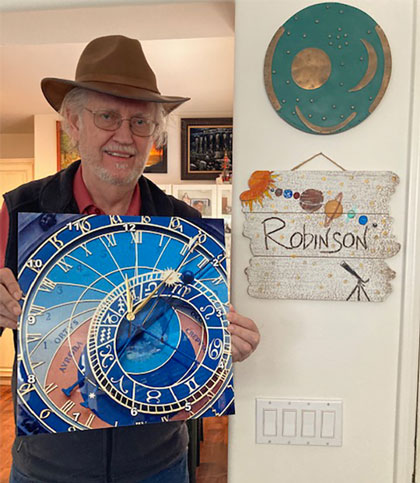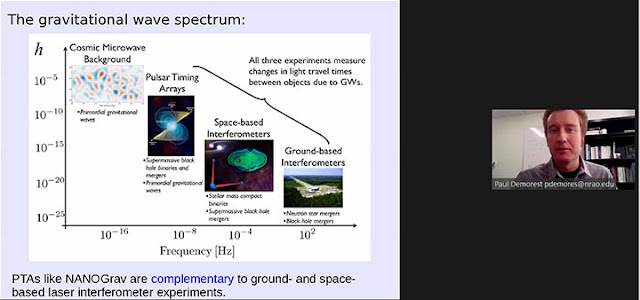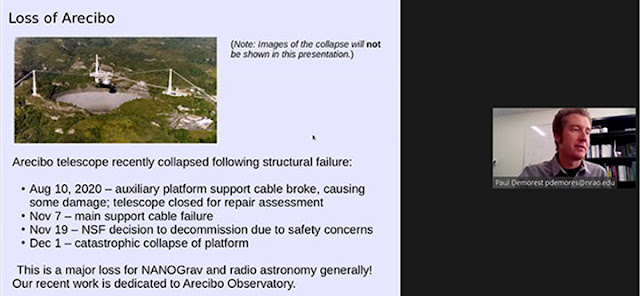Greetings from Palmia Observatory
Earlier in the week we saw some TV show on astronomy and they showed the Orloj Astronomical Clock in Prague. Wo while we wait for the AAS 237th meeting to start, lets detour to that clock.
Here is a picture of the clock, which we understand was built in about the year 1410. Now Resident Astronomer Peggy and I still have active river cruise plans to visit Prague in May, but with the pandemic still unresolved it is not clear if that tour will take place or not. In the meantime, it is interesting to look at some of the astronomical principles of the famous clock.
 |
| Prague Astronomical Clock "Orloj" (Source: Wikipedia) |
You probably have already seen videos of the clock in operation and how on the hour timing various animated action takes place with various figures appearing in the windows and moving around. Pretty neat technology for the 15th century and we still hope to see it in action with our own eyeballs.
You see that in addition to just ordinary 24 hour clock time, the clock incorporates the position of the sun and of the zodiac.
 |
| How the Prague Astronomical Clock works (Source: www.buon.fjfi.cvut.cz) |
So, after seeing the TV show, I clicked on my friends at Amazon and they delivered this wall mounted Orloj clock to our doorstep.
 |
| Wall Clock static replica of Prague Astronomical Clock (Source: Palmia Observatory) |
Sadly, when I opened up the shipping box, I could see that the only moving parts were the ordinary clock hands and the motion of the sun was static only and did not move. Darn! I didn't expect all of the automated motion of the real clock, but I did want the motion of the sun to show up.
But with our modern tools available to us now, you can get the same effect today. Check out this astrolabe app that can be loaded on to your tablet device. It points to the current time and you can watch the planets and sun move above the horizon and onwards. Many of you probably already use some version of modern planetarium software to calculate and predict where in the sky your favorite targets are for observing schedules.
 |
| Astrolabe Clock for iPad (Source: TwoNineEight Software) |
Ok, it is finally time for the AAS 237th meeting to begin. Last year at this time, we were happy to be attending the 236th meeting, live in Hawaii. But now, here we are just waiting in the auditorium online. It is not as exciting as actually being there in person and I do miss all of the excitement.
 |
| Hooray; At least we are attending the AAS 237 meeting online (Source: www.aas.org) |
There were a lot of interesting presentations on the first day, but I will comment on just one of the plenary sessions. The speaker for this session, Dr. Paul Demorest, told us of the current status of the NANOGrav organization. NANOGrav is a large group of radio astronomers who are developing the use of a large network of observed pulsars as a way to detect gravitational waves, which are generated at much lower frequencies that currently observable with LIGO, even much lower than possible with the satellite based LISA. Some of the very low frequency signals will take years of observing time just to detect one cycle of the gravitational wave.
 | |
|
Paul also showed another slide with the ultimate source of gravitational waves being the formation of the early universe. The imprint of early gravitational waves in the CMB is still being sought.
 | |
|
 | |
|
The NANOGrav collaboration is made up of many radio telescopes around the world as seen in this screenshot. He mentioned that new members are being reviewed, partly as a replacement for Arecibo, but also because the measurement of pulsar timing array correlations is easier with more observatories. He mentioned that two observatories, like CHIME in Canada and MeerKAT in South Africa were being considered. A big problem for surveys of this kind is getting the observing time on radio telescopes because of the many other projects seeking observing time.
 |
| International Pulsar Timing Array Collaboration (Source: Paul Demorest, AAS 237) |
In this next slide, Paul described some of the problems with monitoring the pulsar radio signals and trying to get good enough correlations between the various pulsars so that variation of any given pulsar period can be averaged out and the effect of gravitational waves can be measured.
 |
| Looking for GW's in correlations between pulsars (Source: Paul Demorest, AAS 237 |
Paul summarized the 12.5 year study results and how 78 pulsars are not included in the correlation study. He said that the observed correlations are approaching the accuracy and sensitivity to almost be ready to detect gravitational waves. We will have to wait and see!
 |
| Getting close to pinning down correlations between 78 pulsars (Source: Paul Demorest, AAS 237 |
So, that is the first day of the AAS 237th meeting and now we have nighttime opportunities for some observing. You might have tried to capture the near conjunction of Mercury and Jupiter and Saturn. Mercury is just barely visible just after sundown before going below the horizon too. For me, there are usually too many trees on the horizon to photograph it. I might try another location in the next couple of days and see if I can get a photo of Mercury. In the meantime, we still have a chance to observe Mars and Uranus as they continue to move closer and closer till the conjunction on May 20.
This photo of Mars and Mercury was taken with a larger 600mm DSLR telephoto lens with a focal length setting of 150mm. Uranus is still quite dim and its position is marked with a line in the photo.
 |
| Mars nearing Uranus conjunction, DSLR, 150mm, 8 seconds (Source: Palmia Observatory) |
Until next time, here from our burrow, stay safe, as we recover more of our freedom,

No comments:
Post a Comment